- DGK Viper 8.125 Deck Review: An Overall Good Board - April 20, 2022
- Best Skateboard Bearings Guide: All You Need Consider - January 27, 2022
- Most Famous Old School Skateboarders - January 27, 2022
Skateboarding is a sport that can be as laid back and relaxing, or as intense as you want it to be. It can be as chill as cruising around the local area with pals, or it can something as crazy as dropping into a huge vert ramp from a helicopter.
Skateboarding has the flexibility to be whatever you need it to be and appeal to every skill level possible. However, even if you are destined for greatness, we all have to start somewhere and for most of us, the journey starts with a simple Ollie.
An Ollie is the base trick for many others within the sport and for the vast majority of skaters, the first-named trick you will ever learn.
Occasionally you might see someone learn power slides or Shuv-its first. However, if you want to get airborne, there is no substitute for a great ollie. It’s the foundation on which you can build your skateboarding style and that’s why it is essential to learn this one.
So with that in mind, we have come up with a guide that will give you all the information you could ever need about this timeless skateboarding trick. Allowing you to see the history of this trick, learn how to go about doing an ollie and also give you some insight into what variations of this trick you can try. So without further delay, here is our essential Ollie handbook.
What is an Ollie?
In as basic terms as we can put it, an ollie is a jump. The skater will use their dominant foot to pop the board, the leading foot will slide up the grip tape of the board to level it out in the air, and with that motion, the skater will take flight.
This trick is how skaters get off the ground to meet ledges and rails, how they buy themselves time in the air to do flip tricks and rotations and even without those additions, a great ollie done well still looks fantastic, especially if done in a fun or dangerous setting.
As we mentioned, due to this trick being so necessary for progression, it is common to see beginner skaters trying this one pretty relentlessly until they get it down. However, we would suggest that new skaters become comfortable with all the movement fundamentals before they begin working on this trick.
Who Invented The Ollie?
The Ollie was first seen in 1978, when pool and bowl skating was still in its heyday and the Bones Brigade were in full effect.
A skater named Alan Gelfand was the first skater to do a primitive version of the ollie. This movement of tipping the nose up with a scoop/stomp motion on the tail allowed Alan to perform no-handed aerials in pools and bowls.
Something which was simply unheard of at the time. So, since Alan was nicknamed Ollie, this trick has been coined the Ollie.
This trick would be made famous by popular flat ground and technical wizard, Rodney Mullen. In a contest called the Rusty Harris Skate Contest, Rodney performed a flat ground ollie with the same style and technique that skaters use today, with a stomp and slide motion to take flight.
Rodney would win the contest, largely down to this new addition to his repertoire and this would revolutionize the sport forevermore.
What Tricks Do I Need To Know Before I Try Ollies?
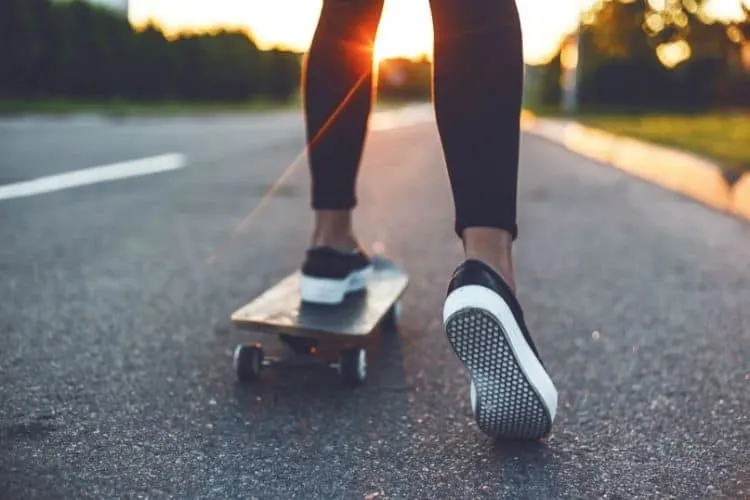
Before we get into the nitty-gritty of how to get your board off the ground. We need to let you know that while this is a beginner trick, there still are some fundamental skills that you’ll need to have before you try this trick.
Firstly, you need to be comfortable moving around on your board, which means you need to be able to balance, move, stop and turn with ease.
We would also suggest that you try so static or short moving manuals so that you become comfortable with the motion of lowering the tail of the board to raise the nose.
Then, to raise those comfort levels further, we would also suggest that skaters try to do some hippy jumps both static and moving on the board to get them used to the jumping motion and landing back on a moving board. This can be scary at first so keep the movement slow until you get a few solid jumps.
There are a few other tricks that you can learn if you don’t feel up to ollies just yet but you still want to progress and learn new things. Here is a list of some of those tricks that you can learn before you ollie. However, unlike the ones mentioned above, these are not essential:
- Fast plants
- Boneless
- No comply
- Tic Tacs
- Shuv-its
How to Ollie: Our Guide
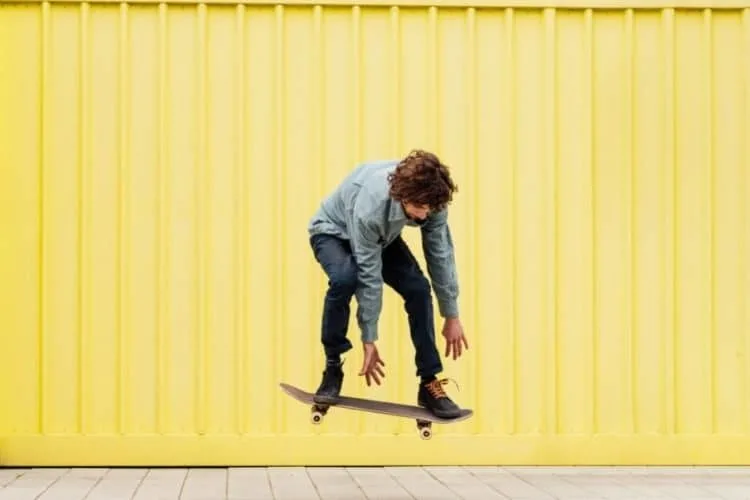
Ok, so you feel up to the challenge of learning to ollie. Well, the good news is that we are here to help and have a step by step guide that will help you take off in no time at all.
However, do remember that all skaters progress at different paces, so if you don’t get the ollie right away, persevere because we guarantee you, skating really opens up after you learn to ollie. But enough of that, it’s time to get learning.
Step One
The first thing you need to do is understand the movement and allow your feet to mimic the movement. What you need to do when on the board is stomp on the tail with your dominant foot and then angle your foot so the outside of your leading foot drags/slides up the grip tape of your board.
Your back foot should be on the tail with the ball of your foot in the pocket. Whereas the leading foot should be placed on or just before the truck bolts at the nose of the board. So initially, go to a grassy area and use this stable, grippy surface to allow you to practice this movement.
Step Two
The next step is trying to put this movement into action. So while still on the grass, we are going to add the jumping motion. So place your feet as suggested above and before stomping the tail. Look at your body position.
Your shoulders should be squared, your knees should be bent and your back should be reasonably straight with just a slight bend. Bend your knees at about 90° and then stomp the tail of the board and at the same time, slide your leading foot toward the nose of the board, maintaining contact with the board at all times.
Step Three
Depending on how fluid and successful your attempt was, you may have briefly left the ground. If you did, good job. If you didn’t, this step should help. We are going to emphasize the pop and slide and forget about the landing. So do the same motion as before but the focus should be on two things.
One, really slams the tail into the ground with the ball of your foot and get a decent pop. Then secondly to allow the board to rise slightly before you slide your foot. There is a tendency for beginners to slam the nose down in a desperate search for stability again.
Fight against that and allow the board to rise, level out and come back down again. You can even take your back foot off after you pop to really focus on this. But don’t move on from this step until you can land on the grass with both feet on the board.
Step Four
Now comes the scary part, moving on to concrete. This will mean that the board will roll under you, meaning your foot position, balance and movement need to be locked in.
We would suggest finding a small crack in the pavement to wedge your wheel in to minimize movement before takeoff and then all you have to focus on is a successful landing. Follow the same pattern of movement as suggested above and this shouldn’t be too tricky.
Key things to remember when moving to the concrete are that you have to straighten your legs before you land or you might lose your balance and to get your body position right as leaning too far in one direction or opening up the shoulders could see your board fly off in any direction, with no cushioned fall on the grass waiting for you.
Step Five
If you get a few static ollies under your belt, it’s time to get those wheels rolling. Start by pushing forward slightly on a flat surface and adjusting your feet into the correct position. Then pop, slide and land as you would have done when static.
If your body position is correct this really shouldn’t feel all too different from static ollies. The only thing we would suggest is that when moving, do your best not to lean back.
With static ollies it’s possible to get away with this. However, when moving the board will come out from under you so stand tall and land with confidence.
What are The Common Mistakes to Avoid?
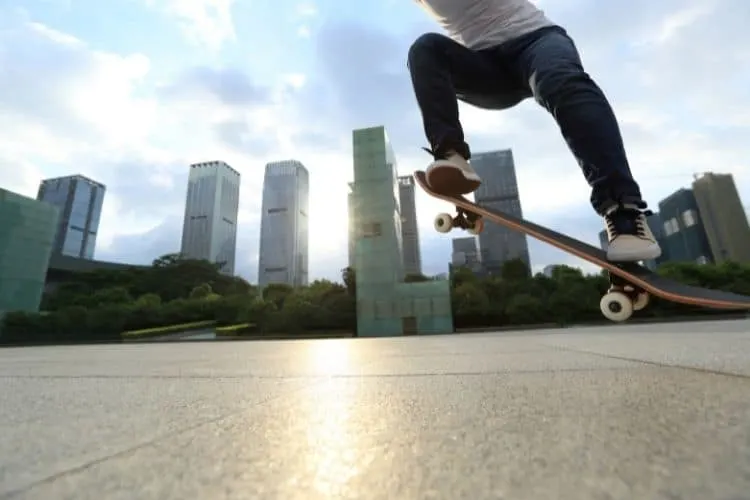
If you are still having issues with your ollie despite the guide above, it may be due to a common mistake you are making that is stopping you from making progress.
These can be hard to correct if no one points out the problem to you. So we want to point out some common Ollie pitfalls and get you back on track, check them out below:
Poor Sliding Technique
A common issue with ollies tends to be that skaters will try to use the sole of their foot to slide up the grip tape and level out the board. While we can understand how you might have made this error, the simple fact of the matter is that your board will almost always land in front of you or fly forward if you try this.
Instead, really emphasize performing this motion with the outside of your foot, so much so that you can see the sole of your shoe as your foot slides up the grip tape. This change should make leveling out the board and landing much easier.
Weight Distribution
A reason why a lot of skaters can’t get any height on their ollie is due to their weight distribution when jumping. Many skaters will keep a lot of weight on their back foot after they have stomped to lift the nose.
In doing this, it stops the board from popping off the ground, renders your slide pointless, and means that you quickly slam the nose to the ground again, never actually leaving the ground.
To fix this, stay on the ball of your foot when popping and as soon as you do, relax the back foot, allowing the board to rise and level out. For some, it can even be easier to remove the back foot slightly after takeoff altogether. So experiment with this until you find your ideal ollie.
Body Position
One of the most common issues with an ollie is one’s body position. This can lead to many issues at take-off and upon landing. For example, if your shoulders are not square the board will ultimately rotate slightly upon take-off and lead to an uncomfortable landing, or you falling off your board.
Or, if you lean back too far on the board, the board will rocket and make landing pretty much impossible for you. So to correct this, ensure that you have square shoulders, aren’t leaning back, forward or side to side. Plus, ensure that you are bending your knees to allow yourself to jump without using your back for leverage.
Is There Any Equipment That Can Help me Learn Ollies?
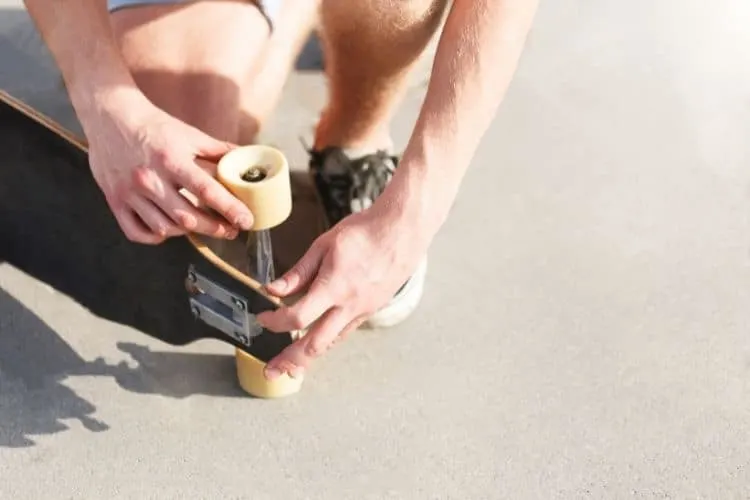
There are a few things that you can use, both when you are learning to ollie and indeed when you are trying to perfect and improve your ollie. The first thing you can use is training wheels. These are rubber coverings for your wheels that allow you to stay static on any surface.
This can help you become more comfortable on concrete, makes landing much easier too and these wheel covers can also help when working on other tricks in the future, so they are a sound investment.
Then as for improving your ollies, the equipment needed is much more easily accessible. We would suggest that skaters use obstacles to increase the distance and height of their ollie. For distance, we would suggest hopping over manhole covers and setting challenges similar to this.
As for height, we would suggest that skaters use curbs, small ledges or perhaps another skateboard to challenge themselves to jump over larger obstacles.
Are There Different Types of Ollie?
Yes, there are absolutely different types of ollies that take the original format and tweak it slightly to make the trick more stylish and more complicated. Here is a list of all the main ollie variations out there:
Ollie North/South
The first variation is the Ollie North or the Ollie South. This trick is very similar to the original ollie, however, the key difference is that the skater will remove either their front or back foot, fully extending their leg in the air before bringing it back into position to land back on the board.
This can feel rather alien but with good core ollie technique and practice, this can be a very good one to add to your setlist.
Boned Ollie
A boned ollie is a much more tricky variation of the ollie which can really add some spice to your trick. This is where you have your legs fully horizontal, out in front of you while in the air, somewhat like a melon grab while the board dips down.
Then you return to the standard stance and land as normal. This can be a very tricky one to do as there is no real way to practice other than getting big air and experimenting. However, if you can pull it off, you’ll be the king or Queen of the park for a day.
180s and 360’s
Probably the most recognisable ollie variations. These simple require the skater to open up their body, wind up their shoulders and release while doing an ollie to rotate in the air. These can also be done with other tweaks such as landing and pivoting/reverting to get the full rotation.
Ghost Ollie
This is a much less common ollie where the skater pops the ollie and then removes both feet from the board, hovering over the board which is still progressing in the flight position of a general ollie. Then placing their feet back on the board and landing.
Body Varial Оllie
This is where the skater will pop a standard ollie and get airborne, then while in mid-air, will open up their body and switch stances with a twist of the body. Then land and ride away switch/fakie.
Chinese Ollie
Then lastly, we have the Chinese Ollie. This is when the skater doesn’t pop the board but rather uses a crack or sharp dip in the pavement to drop the tail and level the board. This is more of a bounce than an actual ollie but it’s still very impressive looking all the same.
How Can I Make My Ollie Higher?
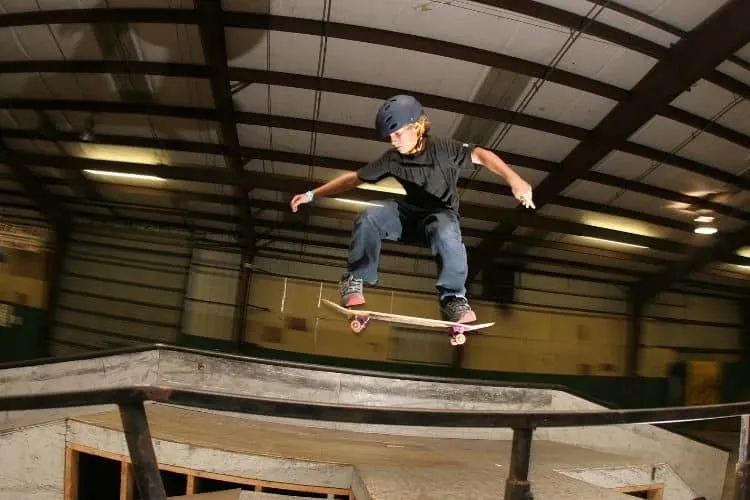
So, now that you have all the info about the ollie and indeed how to do the trick. You may be wondering how you progressively make this trick go higher and higher. Well, we have several things that you can try to make your ollies soar higher than you ever dreamed. Check them out below:
Practice
It’s the simplest, most obvious, and most important tip we can offer. Your ollies will improve as you do more of them, gain more confidence and develop the muscle memory for the trick. We cannot put into words just how important getting out there and shredding is. So please carve out some time to practice every day if you can.
Skate With Experienced Skaters
Another thing that you can do is frequent the park regularly, hang out with guys and gals that have been skating for years on end, and watch what they do. Or better yet, let them give you a few pointers. It’s like swapping your Sunday league football team for the premier league, you’ll simply get better through osmosis.
Skate Lines
While practicing a static ollie will help toward getting a higher pop. Gaining a more natural, stylish and high ollie only happens if you can do it consistently and on the fly.
So let up lines fot yourself to hit. Some obstacles to jump over, some gaps you need to clear or some ledges you need to get up on. Do this and ollies will become second nature.
What is The Highest Ollie on Record?
You may be wondering, what is the highest Ollie on record. Well, it’s something that we can answer for you as it’s recorded as a Guinness World Record.
This was set at SLS by both Xavier Alford and Jake Hayes who both managed to beat Aldrin Garcia’s former record of 44.5 inches by a whole inch, each recording a 45.5 inch Ollie. Each split the prize of 10,000 dollars which was tabled by ETN before the event.
The Foundation of All Skateboard Tricks
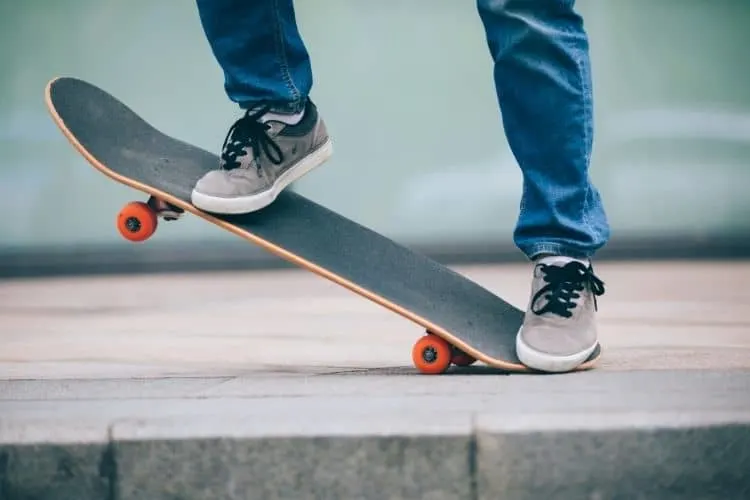
As you can see from the information above, the ollie is one of, if not the most essential skateboarding tricks in your arsenal and one you need to have in your locker if you want to become a proficient skateboarder.
We hope that this guide helps you land your first ollie, gives more intermediate skaters some ollie variations to try and gave you an education on how the ollie came to be. Now get out there and touch the sky.
FAQ Section
If you have reached the end of this guide and you still have some pressing skateboarding questions, maybe our FAQ section will clear up some of those issues. Check it out below:
Answer: Another mention for the Guinness World Book of Records in this article. This time it features Rob Dyrdek and the late, Big Black. Back in the day, the charismatic pair had an excellent show called ‘Rob and Big’ an extension of Rob Dyrdek’s Fantasy Factory.
So in one particular episode, Rob decided to get the world record officials out to his skate park in an attempt to land the most ollies consecutively on record.
The pro skater and TV personality managed to do just that, landing 215 ollies in a row. However, this record was eventually beaten by Nicholas Drachman from Rhode Island who landed 302 ollies in succession, a record that still stands today.
Answer: The simple answer is no. When skaters are riding vert, it’s much rarer that you will see a conventional ollie. You will more often see skaters use the forward momentum of the steep ramps to generate enough speed to launch off the other side and then maintain this momentum throughout their run.
You will also see very skaters using Alan Gelfand’s aerial technique to get over cut out sections of the ramp. Plus, on some occasions, skaters will use a genuine ollie technique to gain distance from the coping when landing. However, in general, ollies are much more common in street and transition.
Answer: Now, this is a much more subjective question but one that we reckon we can give a conclusive answer on. If we are talking pure, not tweaked, no rotation ollies then it has to be the 1997 water tower ollie by Jeremy Wray.
The Plan B skater managed to clear a 16-foot gap between two very large water towers with almost certain death awaiting him had he came up short.
The pro skater managed to clear the gap with some comfort and with the most simple trick in the book, landed one of the most memorable tricks in the history of skating. So for that reason, this is the best ollie ever.
Final Thoughts
So that is our guide explaining most people’s first skateboarding trick, the Ollie. What did you make of this guide? Was this helpful and informative for you?
Are there any other skateboarding guides that you would like to see in the future? Let us know in the comments section below and as always, thank you for reading Skate Culture Insider.
Looking for more interesting readings? Check out:

